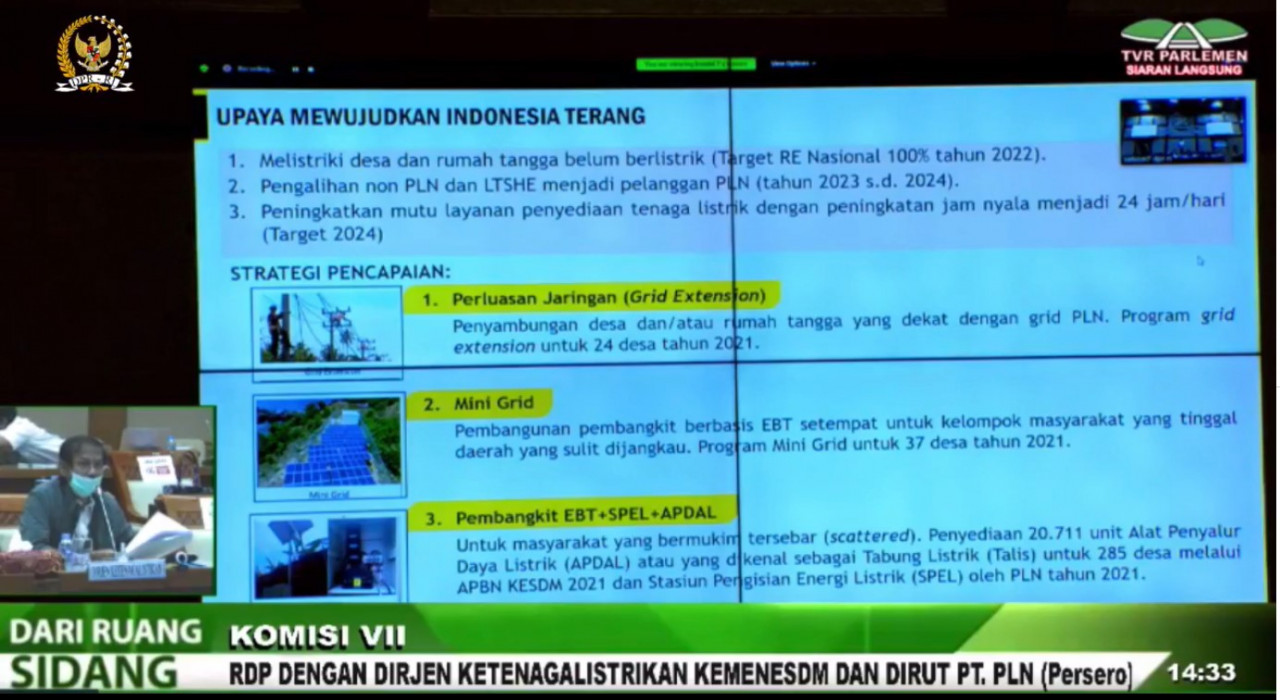
Indonesia to Reach 100% Electrification Ratio in 2022
MINISTRY OF ENERGY AND MINERAL RESOURCES
REPUBLIC OF INDONESIA
PRESS RELEASE
NUMBER: 180.Pers/04/SJI/2020
Date: 28 May 2021
Indonesia to Reach 100% Electrification Ratio in 2022
The Indonesian Ministry of Energy and Mineral Resources (EMR) is optimistic it can reach the electrification ratio of 100%, or providing electricity in all areas across Indonesia, in 2022.
"We will complete (the electrification ratio) next year. The electrification ratio in 2022 can reach 100 percent," said Director General of Electricity, Rida Mulyana, in a hearing (RDP) with Commission VII of the Indonesian House of Representatives (DPR RI) on Thursday (27/5).
To achieve this target, continued Rida, an investment of Rp12.02 trillion is needed. If the available funds are less than this amount, the 100 percent target will be shifted to the next year. "We did a calculation, and it'll need about Rp12.02 trillion. If the funds in the State Budget (APBN) are only Rp5 trillion, the realization of 100 percent of electrification ratio will shift to the next year," said Rida.
Rida spelled out that until Q1 2021, the electrification ratio reached 99.28 percent, while the ratio of electrified villages reached 99.59 percent. The percentage represents 542,124 households that have not had electricity, and 346 villages with no electricity connection. "The data are dynamic," Rida underlined.
Besides the electrification ratio and the electrified village ratio, another component targeted by the government is service quality level. "These are the main components of the Bright Indonesia (Indonesian Terang) Program," explained Rida.
In order to meet these targets, the government and state electricity utility PLN have prepared a number of strategies. "These strategies are highly situational and depend on field surveys," said Rida.
The first strategy is to make massive grid extensions by connecting villages or households that are close to PLN's grids. Grid extensions will be carried out in 24 villages in 2021.
The next pathway in grid extension involves mini grids, namely by developing local, renewables-based power plants for communities living in hard-to-reach areas in 37 villages in 2021.
Finally, another route is by constructing renewables power plants, Electric Charging Stations (SPEL), and Electric Power Supply Equipment (APDAL) for people who live in scattered areas. As many as 20,711 APDAL units, often dubbed 'electricity tubes', will be given to 285 villages in 2021 with funds from the 2021 APBN, while PLN will finance the installation of SPEL units. "This program is currently running," explained Rida.
Another strategy the government has adopted is to build solar power plants and village electricity. The government hopes that isolated areas across Indonesia can get electricity from cheap-and-easy to build power plants.
Additionally, Rida will allow PLN to build diesel power plants in faraway regions. "I told PLN that it's okay to build diesel power plants; I'll turn a blind eye. The point is faraway regions get electricity. After, say, five years, the diesel power plants should be replaced by renewables ones," Rida said.
Rida concluded by emphasizing the need to build electricity transmission in these faraway regions. According to Rida, transmission construction has currently been intensified so as to ensure smooth interconnection. (IY)
Head of Bureau of Communication, Public Information Services, and Cooperation
Agung Pribadi (08112213555)
Share This!





